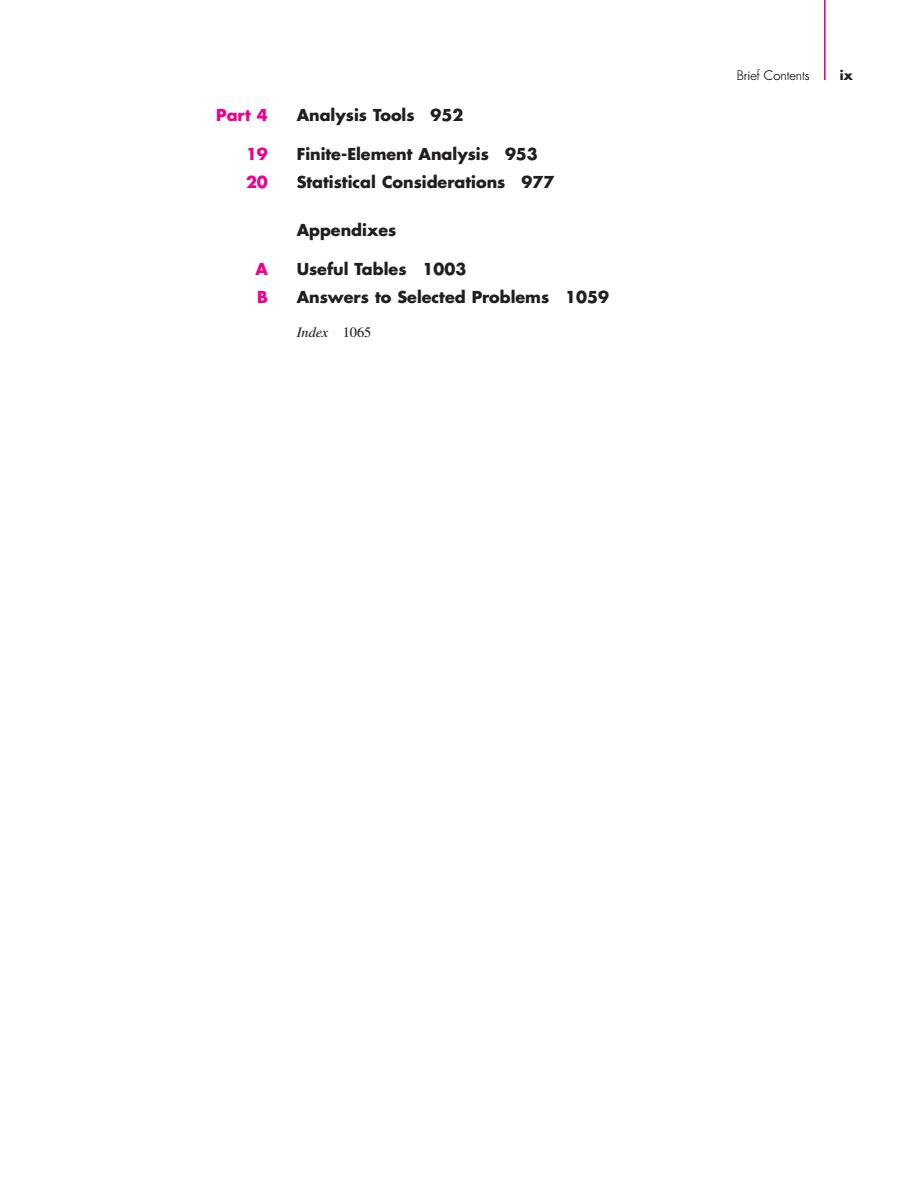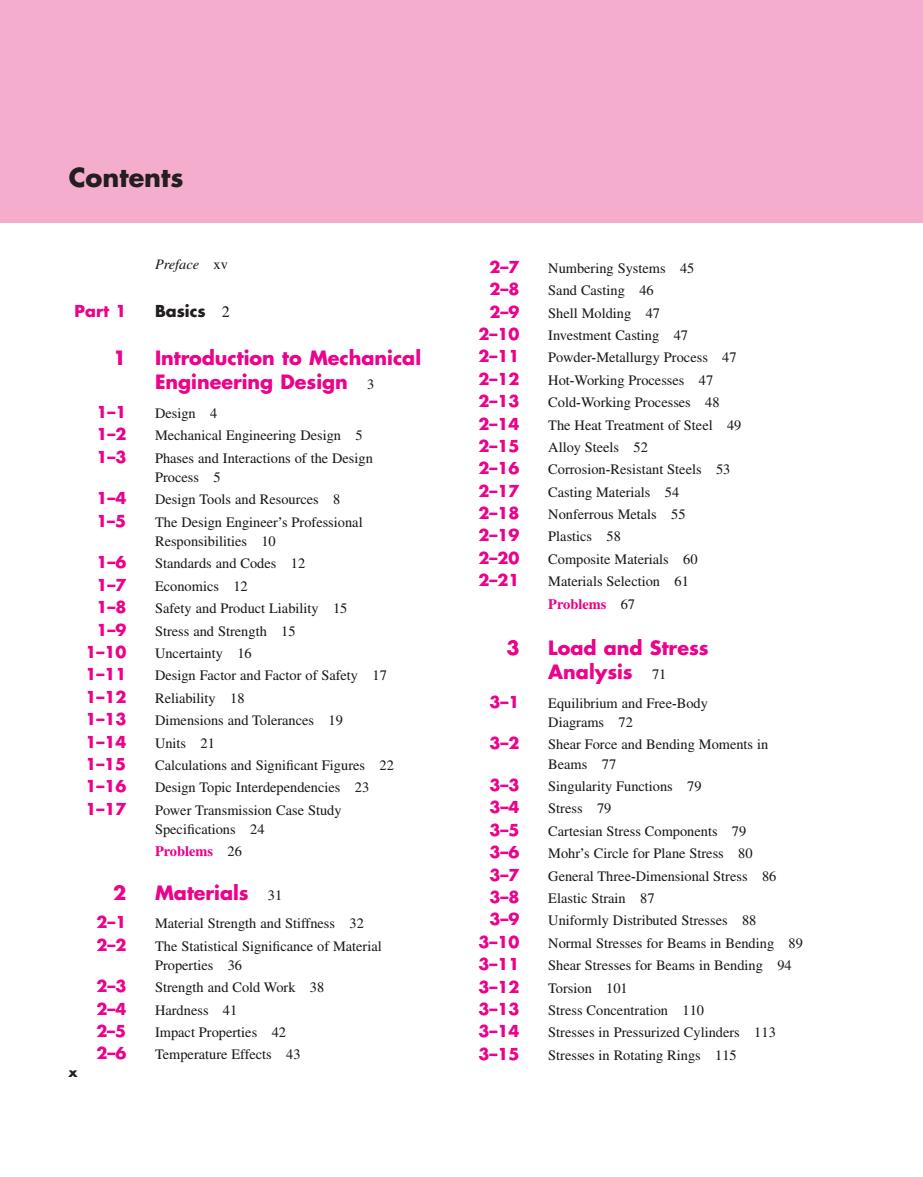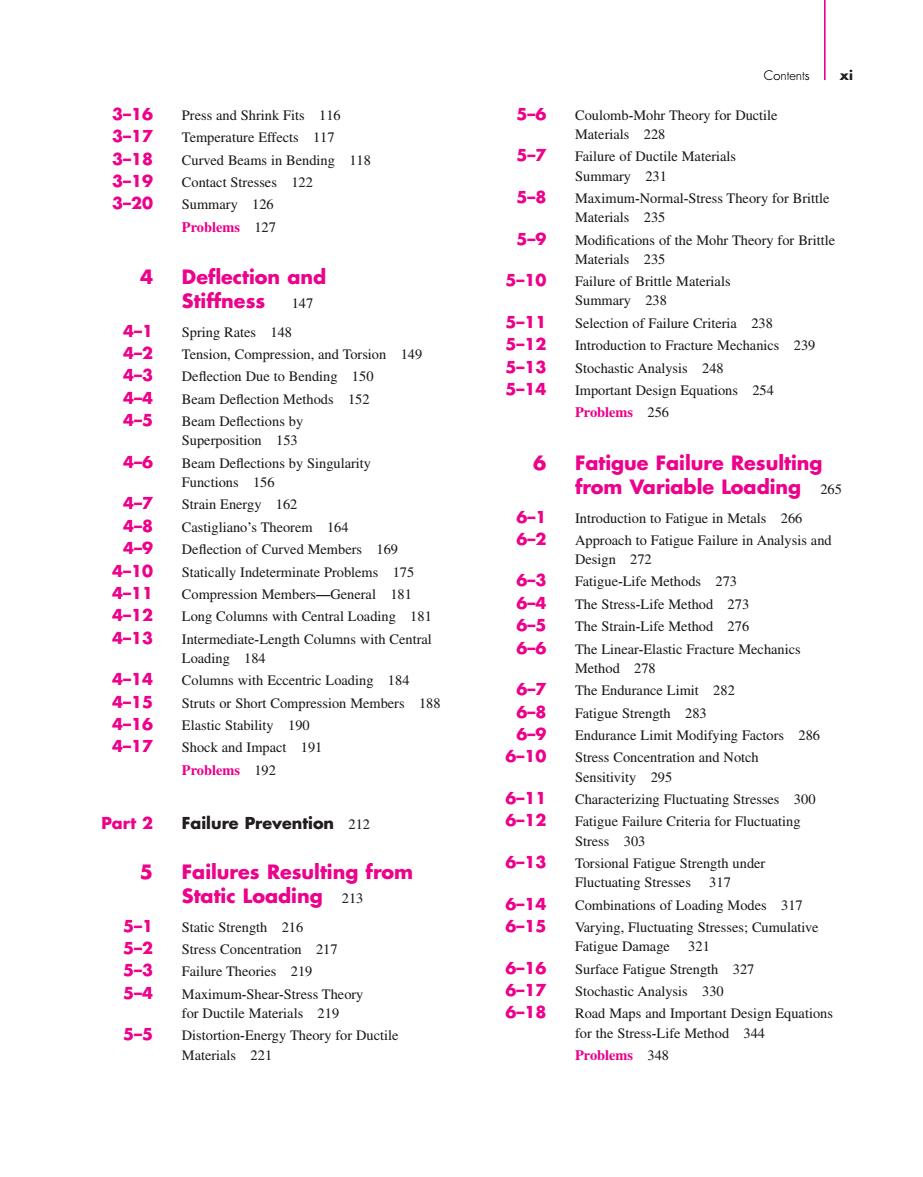
Brief Contents Preface xv Part 1 Basics 2 1 Introduction to Mechanical Engineering Design 3 2 Materials 31 3 Load and Stress Analysis 71 4 Deflection and Stiffness 147 Part 2 Failure Prevention 212 5 Failures Resulting from Static Loading 213 6 Fatigue Failure Resulting from Variable Loading 265 Part 3 Design of Mechanical Elements 358 7 Shafts and Shaft Components 359 8 Screws,Fasteners,and the Design of Nonpermanent Joints 409 9 Welding,Bonding,and the Design of Permanent Joints 475 10 Mechanical Springs 517 11 Rolling-Contact Bearings 569 12 Lubrication and Journal Bearings 617 13 Gears-General 673 14 Spur and Helical Gears 733 15 Bevel and Worm Gears 785 16 Clutches,Brakes,Couplings,and Flywheels 825 17 Flexible Mechanical Elements 879 18 Power Transmission Case Study 933 vili
Brief Contents Preface xv Part 1 Basics 2 1 Introduction to Mechanical Engineering Design 3 2 Materials 31 3 Load and Stress Analysis 71 4 Deflection and Stiffness 147 Part 2 Failure Prevention 212 5 Failures Resulting from Static Loading 213 6 Fatigue Failure Resulting from Variable Loading 265 Part 3 Design of Mechanical Elements 358 7 Shafts and Shaft Components 359 8 Screws, Fasteners, and the Design of Nonpermanent Joints 409 9 Welding, Bonding, and the Design of Permanent Joints 475 10 Mechanical Springs 517 11 Rolling-Contact Bearings 569 12 Lubrication and Journal Bearings 617 13 Gears—General 673 14 Spur and Helical Gears 733 15 Bevel and Worm Gears 785 16 Clutches, Brakes, Couplings, and Flywheels 825 17 Flexible Mechanical Elements 879 18 Power Transmission Case Study 933 viii bud29281_fm_i-xxii_1.qxd 12/24/09 3:38 PM Page viii epg Disk1:Desktop Folder:TEMPWORK:Don't-Delete Jobs:MHDQ196/Budynas:

Brief Contents ix Part 4 Analysis Tools 952 19 Finite-Element Analysis 953 20 Statistical Considerations 977 Appendixes A Useful Tables 1003 B Answers to Selected Problems 1059 Index 1065
Part 4 Analysis Tools 952 19 Finite-Element Analysis 953 20 Statistical Considerations 977 Appendixes A Useful Tables 1003 B Answers to Selected Problems 1059 Index 1065 Brief Contents ix bud29281_fm_i-xxii_1.qxd 12/24/09 3:38 PM Page ix epg Disk1:Desktop Folder:TEMPWORK:Don't-Delete Jobs:MHDQ196/Budynas:

Contents Preface xv 2-7 Numbering Systems 45 2-8 Sand Casting 46 Part 1 Basics 2 2-9 Shell Molding 47 2-10 Investment Casting 47 1 Introduction to Mechanical 2-11 Powder-Metallurgy Process 47 Engineering Design 3 2-12 Hot-Working Processes 47 2-13 Cold-Working Processes 48 1-1 Design 4 1-2 2-14 The Heat Treatment of Steel 49 Mechanical Engineering Design 5 2-15 1-3 Alloy Steels 52 Phases and Interactions of the Design 2-16 Corrosion-Resistant Steels 53 Process 5 1-4 Design Tools and Resources 8 2-17 Casting Materials 54 1-5 The Design Engineer's Professional 2-18 Nonferrous Metals 55 Responsibilities 10 2-19 Plastics 58 1-6 Standards and Codes 12 2-20 Composite Materials 60 1-7 Economics 12 2-21 Materials Selection 61 1-8 Safety and Product Liability 15 Problems 67 1-9 Stress and Strength 15 1-10 Uncertainty 16 3 Load and Stress 1-11 Design Factor and Factor of Safety 17 Analysis 71 1-12 Reliability 18 3-1 Equilibrium and Free-Body 1-13 Dimensions and Tolerances 19 Diagrams 72 1-14 Units 21 3-2 Shear Force and Bending Moments in 1-15 Calculations and Significant Figures 22 Beams 77 1-16 Design Topic Interdependencies 23 3-3 Singularity Functions 79 1-17 Power Transmission Case Study 3-4 Stress 79 Specifications 24 3-5 Cartesian Stress Components 79 Problems 26 3-6 Mohr's Circle for Plane Stress 80 3-7 General Three-Dimensional Stress 86 2 Materials 31 3-8 Elastic Strain 87 2-1 Material Strength and Stiffness 32 3-9 Uniformly Distributed Stresses 88 2-2 The Statistical Significance of Material 3-10 Normal Stresses for Beams in Bending 89 Properties 36 3-11 Shear Stresses for Beams in Bending 94 2-3 Strength and Cold Work 38 3-12 Torsion 101 2-4 Hardness 41 3-13 Stress Concentration 110 2-5 Impact Properties 42 3-14 Stresses in Pressurized Cylinders 113 2-6 Temperature Effects 43 3-15 Stresses in Rotating Rings 115 X
Preface xv Part 1 Basics 2 1 Introduction to Mechanical Engineering Design 3 1–1 Design 4 1–2 Mechanical Engineering Design 5 1–3 Phases and Interactions of the Design Process 5 1–4 Design Tools and Resources 8 1–5 The Design Engineer’s Professional Responsibilities 10 1–6 Standards and Codes 12 1–7 Economics 12 1–8 Safety and Product Liability 15 1–9 Stress and Strength 15 1–10 Uncertainty 16 1–11 Design Factor and Factor of Safety 17 1–12 Reliability 18 1–13 Dimensions and Tolerances 19 1–14 Units 21 1–15 Calculations and Significant Figures 22 1–16 Design Topic Interdependencies 23 1–17 Power Transmission Case Study Specifications 24 Problems 26 2 Materials 31 2–1 Material Strength and Stiffness 32 2–2 The Statistical Significance of Material Properties 36 2–3 Strength and Cold Work 38 2–4 Hardness 41 2–5 Impact Properties 42 2–6 Temperature Effects 43 Contents 2–7 Numbering Systems 45 2–8 Sand Casting 46 2–9 Shell Molding 47 2–10 Investment Casting 47 2–11 Powder-Metallurgy Process 47 2–12 Hot-Working Processes 47 2–13 Cold-Working Processes 48 2–14 The Heat Treatment of Steel 49 2–15 Alloy Steels 52 2–16 Corrosion-Resistant Steels 53 2–17 Casting Materials 54 2–18 Nonferrous Metals 55 2–19 Plastics 58 2–20 Composite Materials 60 2–21 Materials Selection 61 Problems 67 3 Load and Stress Analysis 71 3–1 Equilibrium and Free-Body Diagrams 72 3–2 Shear Force and Bending Moments in Beams 77 3–3 Singularity Functions 79 3–4 Stress 79 3–5 Cartesian Stress Components 79 3–6 Mohr’s Circle for Plane Stress 80 3–7 General Three-Dimensional Stress 86 3–8 Elastic Strain 87 3–9 Uniformly Distributed Stresses 88 3–10 Normal Stresses for Beams in Bending 89 3–11 Shear Stresses for Beams in Bending 94 3–12 Torsion 101 3–13 Stress Concentration 110 3–14 Stresses in Pressurized Cylinders 113 3–15 Stresses in Rotating Rings 115 x bud29281_fm_i-xxii_1.qxd 12/24/09 3:38 PM Page x epg Disk1:Desktop Folder:TEMPWORK:Don't-Delete Jobs:MHDQ196/Budynas:

Contents 3-16 Press and Shrink Fits 116 5-6 Coulomb-Mohr Theory for Ductile 3-17 Temperature Effects 117 Materials 228 3-18 Curved Beams in Bending 118 5-7 Failure of Ductile Materials 3-19 Contact Stresses 122 Summary 231 3-20 Summary 126 5-8 Maximum-Normal-Stress Theory for Brittle Materials 235 Problems 127 5-9 Modifications of the Mohr Theory for Brittle Materials 235 4 Deflection and 5-10 Failure of Brittle Materials Stiffness 147 Summary 238 4-1 5-11 Selection of Failure Criteria 238 Spring Rates 148 4-2 5-12 Introduction to Fracture Mechanics 239 Tension,Compression.and Torsion 149 4-3 5-13 Stochastic Analysis 248 Deflection Due to Bending 150 4-4 5-14 Beam Deflection Methods 152 Important Design Equations 254 4-5 Problems 256 Beam Deflections by Superposition 153 4-6 Beam Deflections by Singularity 6 Fatigue Failure Resulting Functions 156 from Variable Loading 265 4-7 Strain Energy 162 4-8 Castigliano's Theorem 164 6-1 Introduction to Fatigue in Metals 266 4-9 6-2 Approach to Fatigue Failure in Analysis and Deflection of Curved Members 169 Design 272 4-10 Statically Indeterminate Problems 175 6-3 Fatigue-Life Methods 273 4-11 Compression Members-General 181 6-4 The Stress-Life Method 273 4-12 Long Columns with Central Loading 181 6-5 The Strain-Life Method 276 4-13 Intermediate-Length Columns with Central 6-6 The Linear-Elastic Fracture Mechanics Loading 184 Method 278 4-14 Columns with Eccentric Loading 184 6-7 The Endurance Limit 282 4-15 Struts or Short Compression Members 188 6-8 Fatigue Strength 283 4-16 Elastic Stability 190 6-9 Endurance Limit Modifying Factors 286 4-17 Shock and Impact 191 6-10 Stress Concentration and Notch Problems 192 Sensitivity 295 6-11 Characterizing Fluctuating Stresses 300 Part 2 Failure Prevention 212 6-12 Fatigue Failure Criteria for Fluctuating Stress 303 6-13 5 Failures Resulting from Torsional Fatigue Strength under Fluctuating Stresses 317 Static Loading 213 6-14 Combinations of Loading Modes 317 5-1 Static Strength 216 6-15 Varying,Fluctuating Stresses:Cumulative 5-2 Stress Concentration 217 Fatigue Damage 321 5-3 Failure Theories 219 6-16 Surface Fatigue Strength 327 5-4 Maximum-Shear-Stress Theory 6-17 Stochastic Analysis 330 for Ductile Materials 219 6-18 Road Maps and Important Design Equations 5-5 Distortion-Energy Theory for Ductile for the Stress-Life Method 344 Materials 221 Problems 348
3–16 Press and Shrink Fits 116 3–17 Temperature Effects 117 3–18 Curved Beams in Bending 118 3–19 Contact Stresses 122 3–20 Summary 126 Problems 127 4 Deflection and Stiffness 147 4–1 Spring Rates 148 4–2 Tension, Compression, and Torsion 149 4–3 Deflection Due to Bending 150 4–4 Beam Deflection Methods 152 4–5 Beam Deflections by Superposition 153 4–6 Beam Deflections by Singularity Functions 156 4–7 Strain Energy 162 4–8 Castigliano’s Theorem 164 4–9 Deflection of Curved Members 169 4–10 Statically Indeterminate Problems 175 4–11 Compression Members—General 181 4–12 Long Columns with Central Loading 181 4–13 Intermediate-Length Columns with Central Loading 184 4–14 Columns with Eccentric Loading 184 4–15 Struts or Short Compression Members 188 4–16 Elastic Stability 190 4–17 Shock and Impact 191 Problems 192 Part 2 Failure Prevention 212 5 Failures Resulting from Static Loading 213 5–1 Static Strength 216 5–2 Stress Concentration 217 5–3 Failure Theories 219 5–4 Maximum-Shear-Stress Theory for Ductile Materials 219 5–5 Distortion-Energy Theory for Ductile Materials 221 5–6 Coulomb-Mohr Theory for Ductile Materials 228 5–7 Failure of Ductile Materials Summary 231 5–8 Maximum-Normal-Stress Theory for Brittle Materials 235 5–9 Modifications of the Mohr Theory for Brittle Materials 235 5–10 Failure of Brittle Materials Summary 238 5–11 Selection of Failure Criteria 238 5–12 Introduction to Fracture Mechanics 239 5–13 Stochastic Analysis 248 5–14 Important Design Equations 254 Problems 256 6 Fatigue Failure Resulting from Variable Loading 265 6–1 Introduction to Fatigue in Metals 266 6–2 Approach to Fatigue Failure in Analysis and Design 272 6–3 Fatigue-Life Methods 273 6–4 The Stress-Life Method 273 6–5 The Strain-Life Method 276 6–6 The Linear-Elastic Fracture Mechanics Method 278 6–7 The Endurance Limit 282 6–8 Fatigue Strength 283 6–9 Endurance Limit Modifying Factors 286 6–10 Stress Concentration and Notch Sensitivity 295 6–11 Characterizing Fluctuating Stresses 300 6–12 Fatigue Failure Criteria for Fluctuating Stress 303 6–13 Torsional Fatigue Strength under Fluctuating Stresses 317 6–14 Combinations of Loading Modes 317 6–15 Varying, Fluctuating Stresses; Cumulative Fatigue Damage 321 6–16 Surface Fatigue Strength 327 6–17 Stochastic Analysis 330 6–18 Road Maps and Important Design Equations for the Stress-Life Method 344 Problems 348 Contents xi bud29281_fm_i-xxii_1.qxd 12/24/09 3:38 PM Page xi epg Disk1:Desktop Folder:TEMPWORK:Don't-Delete Jobs:MHDQ196/Budynas:

xii Mechanical Engineering Design Part 3 Design of Mechanical 9-5 The Strength of Welded Joints 489 Elements 358 9-6 Static Loading 492 9-7 Fatigue Loading 496 7 Shafts and Shaft 9-8 Resistance Welding 498 Components 359 9-9 Adhesive Bonding 498 Problems 507 7-1 Introduction 360 7-2 Shaft Materials 360 10 Mechanical Springs 517 7-3 Shaft Layout 361 7-4 Shaft Design for Stress 366 10-1 Stresses in Helical Springs 518 7-5 Deflection Considerations 379 10-2 The Curvature Effect 519 7-6 Critical Speeds for Shafts 383 10-3 Deflection of Helical Springs 520 7-7 Miscellaneous Shaft Components 388 10-4 Compression Springs 520 7-8 Limits and Fits 395 10-5 Stability 522 Problems 400 10-6 Spring Materials 523 10-7 Helical Compression Spring Design for Static Service 528 8 Screws,Fasteners,and the 10-8 Critical Frequency of Helical Springs 534 Design of Nonpermanent 10-9 Fatigue Loading of Helical Compression Joints 409 Springs 536 8-1 10-10 Thread Standards and Definitions 410 Helical Compression Spring Design for Fatigue Loading 539 8-2 The Mechanics of Power Screws 414 10-11 8-3 Extension Springs 542 Threaded Fasteners 422 10-12 Helical Coil Torsion Springs 550 8-4 Joints-Fastener Stiffness 424 10-13 8-5 Belleville Springs 557 Joints-Member Stiffness 427 10-14 8-6 Miscellaneous Springs 558 Bolt Strength 432 10-15 Summary 560 8-7 Tension Joints-The External Load 435 Problems 560 8-8 Relating Bolt Torque to Bolt Tension 437 8-9 Statically Loaded Tension Joint with Preload 440 11 Rolling-Contact 8-10 Gasketed Joints 444 Bearings 569 8-11 Fatigue Loading of Tension Joints 444 11-1 Bearing Types 570 8-12 Bolted and Riveted Joints Loaded in 11-2 Bearing Life 573 Shear 451 11-3 Bearing Load Life at Rated Reliability 574 Problems 459 11-4 Bearing Survival:Reliability versus Life 576 9 Welding,Bonding, 11-5 Relating Load,Life,and Reliability 577 and the Design 11-6 Combined Radial and Thrust Loading 579 of Permanent Joints 475 11-7 Variable Loading 584 11-8 Selection of Ball and Cylindrical Roller 9-1 Welding Symbols 476 Bearings 588 9-2 Butt and Fillet Welds 478 11-9 Selection of Tapered Roller Bearings 590 9-3 Stresses in Welded Joints in Torsion 482 11-10 Design Assessment for Selected 9-4 Stresses in Welded Joints in Bending 487 Rolling-Contact Bearings 599
xii Mechanical Engineering Design Part 3 Design of Mechanical Elements 358 7 Shafts and Shaft Components 359 7–1 Introduction 360 7–2 Shaft Materials 360 7–3 Shaft Layout 361 7–4 Shaft Design for Stress 366 7–5 Deflection Considerations 379 7–6 Critical Speeds for Shafts 383 7–7 Miscellaneous Shaft Components 388 7–8 Limits and Fits 395 Problems 400 8 Screws, Fasteners, and the Design of Nonpermanent Joints 409 8–1 Thread Standards and Definitions 410 8–2 The Mechanics of Power Screws 414 8–3 Threaded Fasteners 422 8–4 Joints—Fastener Stiffness 424 8–5 Joints—Member Stiffness 427 8–6 Bolt Strength 432 8–7 Tension Joints—The External Load 435 8–8 Relating Bolt Torque to Bolt Tension 437 8–9 Statically Loaded Tension Joint with Preload 440 8–10 Gasketed Joints 444 8–11 Fatigue Loading of Tension Joints 444 8–12 Bolted and Riveted Joints Loaded in Shear 451 Problems 459 9 Welding, Bonding, and the Design of Permanent Joints 475 9–1 Welding Symbols 476 9–2 Butt and Fillet Welds 478 9–3 Stresses in Welded Joints in Torsion 482 9–4 Stresses in Welded Joints in Bending 487 9–5 The Strength of Welded Joints 489 9–6 Static Loading 492 9–7 Fatigue Loading 496 9–8 Resistance Welding 498 9–9 Adhesive Bonding 498 Problems 507 10 Mechanical Springs 517 10–1 Stresses in Helical Springs 518 10–2 The Curvature Effect 519 10–3 Deflection of Helical Springs 520 10–4 Compression Springs 520 10–5 Stability 522 10–6 Spring Materials 523 10–7 Helical Compression Spring Design for Static Service 528 10–8 Critical Frequency of Helical Springs 534 10–9 Fatigue Loading of Helical Compression Springs 536 10–10 Helical Compression Spring Design for Fatigue Loading 539 10–11 Extension Springs 542 10–12 Helical Coil Torsion Springs 550 10–13 Belleville Springs 557 10–14 Miscellaneous Springs 558 10–15 Summary 560 Problems 560 11 Rolling-Contact Bearings 569 11–1 Bearing Types 570 11–2 Bearing Life 573 11–3 Bearing Load Life at Rated Reliability 574 11–4 Bearing Survival: Reliability versus Life 576 11–5 Relating Load, Life, and Reliability 577 11–6 Combined Radial and Thrust Loading 579 11–7 Variable Loading 584 11–8 Selection of Ball and Cylindrical Roller Bearings 588 11–9 Selection of Tapered Roller Bearings 590 11–10 Design Assessment for Selected Rolling-Contact Bearings 599 bud29281_fm_i-xxii_1.qxd 12/24/09 3:38 PM Page xii epg Disk1:Desktop Folder:TEMPWORK:Don't-Delete Jobs:MHDQ196/Budynas: